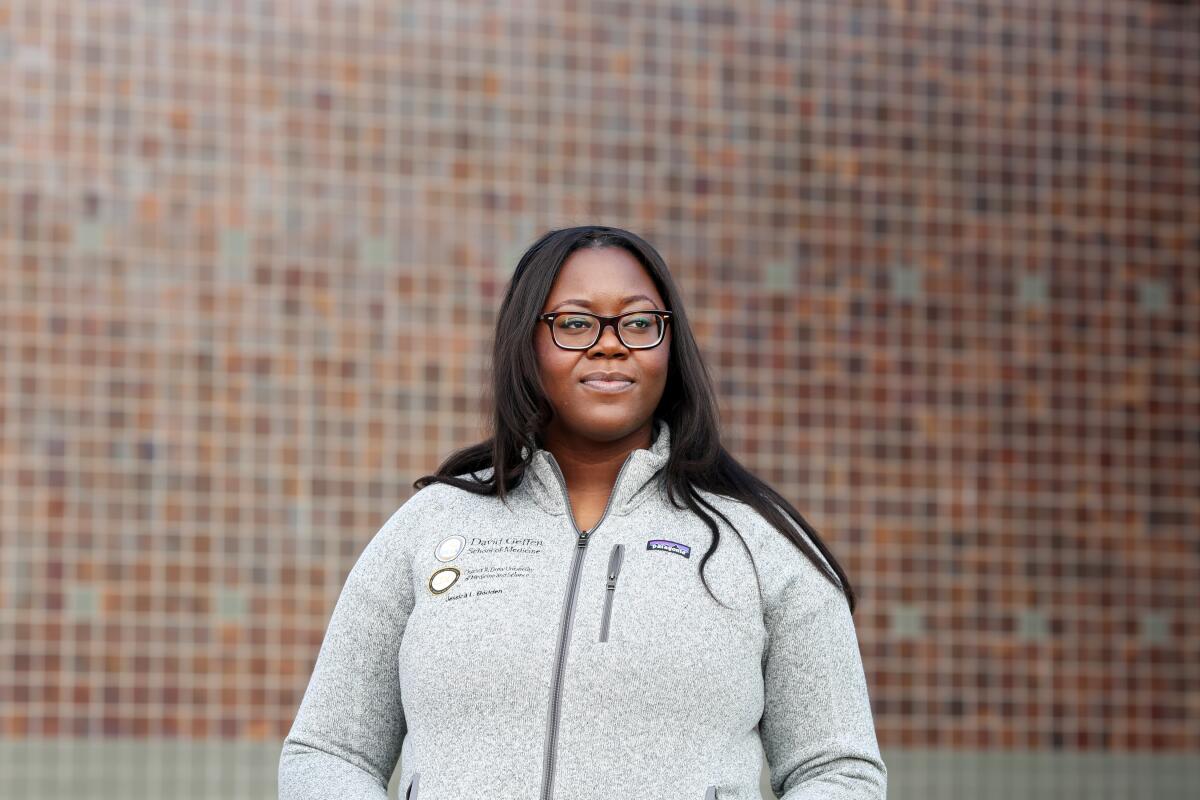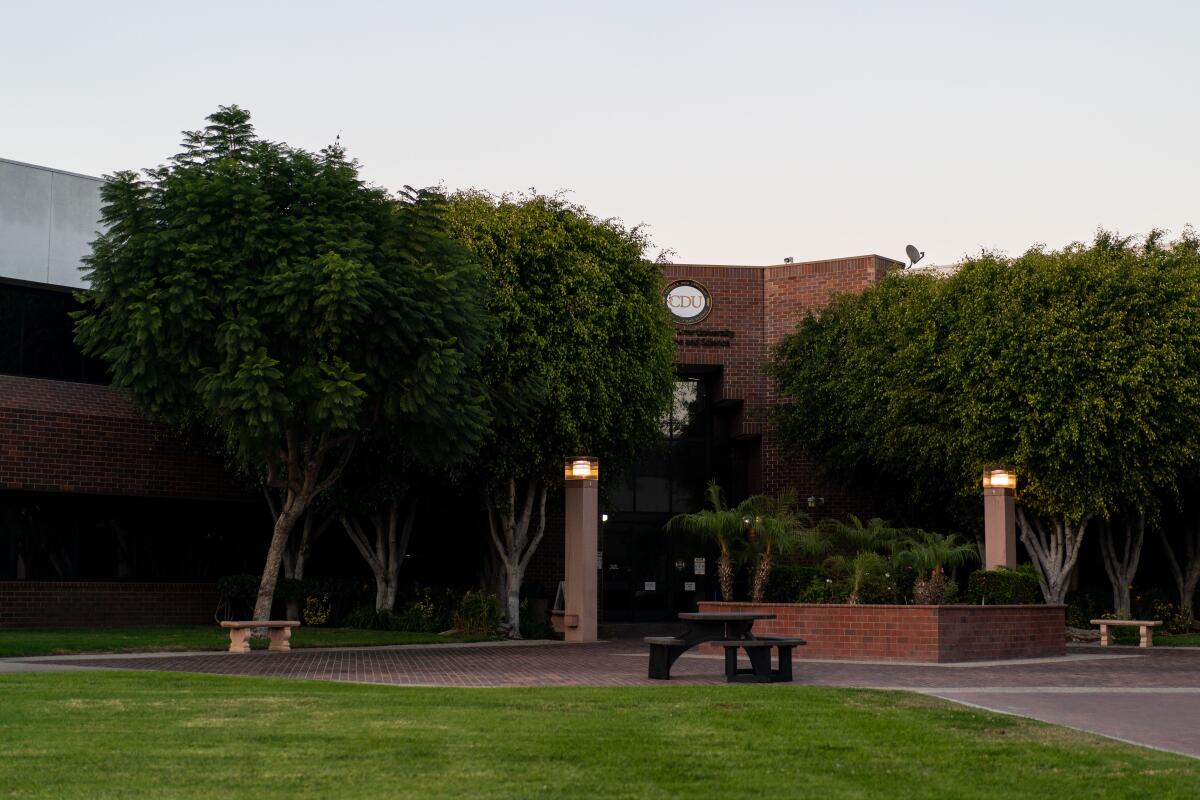South L.A. medical school receives $7.7-million grant from Bloomberg Philanthropies

- Share via
When Jessica Bodden was accepted into medical school six years ago, she didn’t realize the amount of loans she’d be saddled with.
The South Los Angeles native completed her undergraduate degree in California with relatively low debt. But when it was time to pay first-year tuition at her dream medical school, Charles R. Drew University of Medicine and Science, a private, nonprofit, historically Black institution in L.A.’s Willowbrook district, she began relying heavily on need-based scholarships and loans to pay the bill.
Coming from a household that made less than $25,000 annually, and as the mother of a 2-year-old son, Bodden was forced to borrow heavily, sinking her into student debt of more than $200,000. She also took a two-year break from medical school to get a master’s in public health at the UCLA Fielding School of Public Health.
But as her fourth-year anxieties were creeping up, Bodden’s medical school announced in September that it would deduct up to $100,000 from each Black and Latino student’s debt as part of a $7.7-million grant from Bloomberg Philanthropies. The grant, which is the largest private gift the university has received in its 54-year history, will benefit 82 currently enrolled medical students.
“I just remember feeling chills all over my body,” said Bodden, 29. “Because for a little girl like me, from South L.A., I didn’t go to medical school on scholarships. I had to fight for every single scholarship that I won after I was admitted. So it was just really nice just to have someone give.”

Charles R. Drew University — which is recognized as a historically Black graduate institution, or HBGI — is one of four historically Black medical colleges to be awarded funds as part of Bloomberg Philanthropies’ $100-million commitment to help increase the number of Black doctors in the country by reducing their debt burden. The other schools are Howard University College of Medicine in Washington, Meharry Medical College in Nashville and Morehouse School of Medicine in Atlanta. The $100-million gift was split among the schools based on student population.
The grant is part of founder Michael R. Bloomberg’s Greenwood Initiative, an effort created this year in response to the long-lasting effects of the 1921 Tulsa race massacre. The initiative strives to accelerate the pace of Black wealth accumulation and address decades of systemic underinvestment in Black communities.
“COVID-19 has been especially devastating for the Black community, and the scarcity of Black doctors practicing in Black communities is one reason for it,” said Bloomberg, founder of Bloomberg Philanthropies and Bloomberg LP and former mayor of New York City.
“More Black doctors will mean more Black lives saved and fewer health problems that limit economic opportunity. But right now, the burden of student debt and lack of financial aid means that the shortage of Black doctors could get even worse,” he said in a statement.
Among students with education debt, the average amount is $200,000, according to the Assn. of American Medical Colleges. Deborah Prothrow-Stith, Charles R. Drew University dean and professor of medicine, who earned her degree at Harvard Medical School, understands firsthand the financial burden faced by many of her students who come from under-resourced families and neighborhoods.
“It took me like 20 years to pay off my medical school debt. I wish somebody had taken half of it away,” Prothrow-Stith said.
“Medical school is expensive, and you don’t want students who come here because they want to serve their community to get so in debt that they then have to choose to do other things to make money,” Prothrow-Stith added. “So this is really a big gift for us.”
More than 85% of the school’s students report that they intend to practice and provide care in underserved communities after graduation, which is a figure the university’s faculty aims to continue growing.

Charles R. Drew University, which was named after a pioneering Black surgeon who produced seminal work on blood banking, was founded in 1966 in response to inadequate medical facilities within the Watts area during the 1965 riots.
With more than 80% of students and 71% of faculty from communities of color, the university has become a leader in health disparities research with a focus on education, training, treatment and care in cancer, diabetes, cardiometabolic conditions and HIV/AIDS. As the state has been grappling with a surge in COVID-19 patients, Charles R. Drew University also hosted one of the largest testing sites in South L.A., offering walk-up, drive-in and same-day testing. Many students volunteered at the site.

For Kalonji Cole, a fourth-year medical student at the university, the Bloomberg grant was good news in an otherwise challenging year.
With “all of the craziness that 2020 has come with and all the kind of havoc COVID-19 has wrecked, I was pretty much in a state where I was just used to getting bad news, and then this came and it was just amazing,” the 26-year-old said.
“It just lifted my spirits up so much [and] gave me so much less anxiety going forward,” said Cole, who moved to Los Angeles from Tallahassee, Fla., to attend the university in 2017.
Much like Bodden, who is pursuing psychiatry after graduation, Cole has been paying for school mostly through loans. But now that he knows nearly half of his tuition will be covered by the Bloomberg grant, he has more time to focus on applying for residency programs for internal medicine.
“Now, not having to be as stressed about our financial debt just really allows us to kind of breathe easy and to also even further sink our teeth into the mission of [CDU] and do right by our patients, and really do our part in helping to alleviate these healthcare disparities,” he said.
Although the university has racked up several distinctions — its website says it’s the seventh-highest college in California in median annual earnings of former students one year after graduation — the university is not as well known as the most prominent medical schools. Prothrow-Stith said recognition from Bloomberg Philanthropies is already changing that.
“In many ways, CDU is still this hidden gem. It’s not even as well known locally as we hope to see in the future, so one of the important aspects of the gift is that it [brings] visibility,” she said. “That visibility has created more opportunities for us especially in the development and fundraising area.”
The school plans to erect a new medical school building and add a second medical degree that would be awarded solely by Charles R. Drew University. (The school’s current medicine degree is jointly awarded with the David Geffen School of Medicine at UCLA.)
Dr. David M. Carlisle, president and chief executive of Charles R. Drew University, said the new addition will nearly triple the number of students who graduate from the school, which will ultimately “make a significant impact on the physician workforce in the state of California.”
As more eyes shift to the South L.A. university, Prothrow-Stith said, the university plans to continue to train more physicians of color to serve the diverse community.
“We do well at CDU and we want to do more of that because society needs it,” she said. “We need it for things like a pandemic.”
More to Read
Sign up for Essential California
The most important California stories and recommendations in your inbox every morning.
You may occasionally receive promotional content from the Los Angeles Times.














